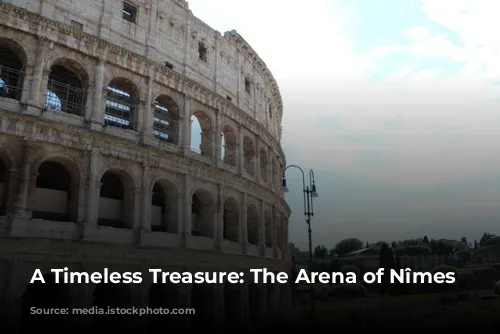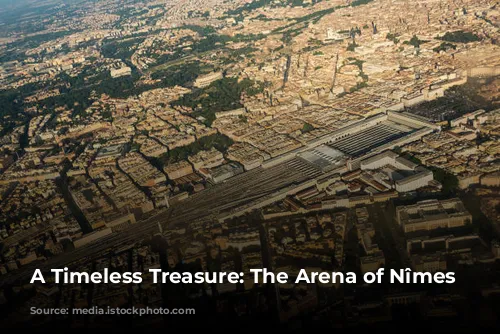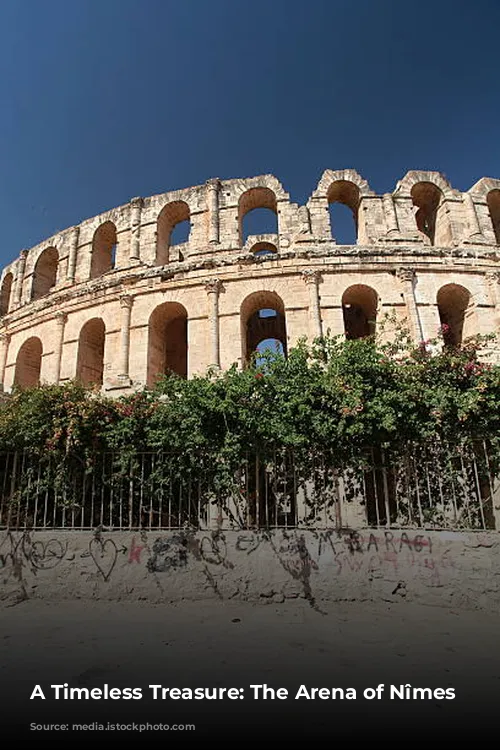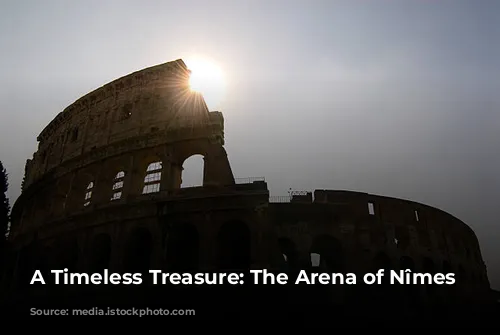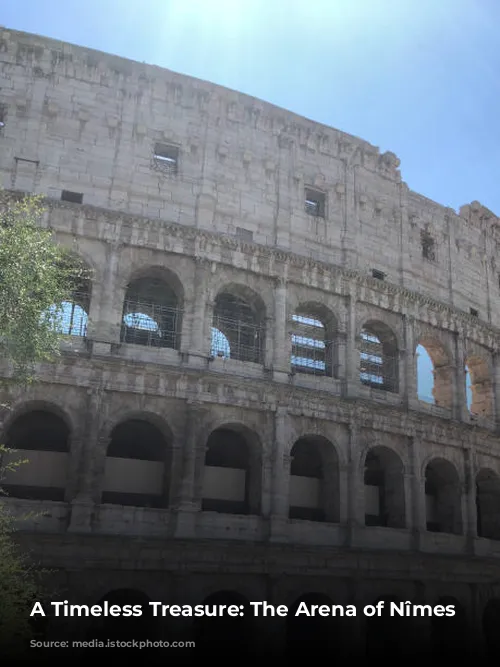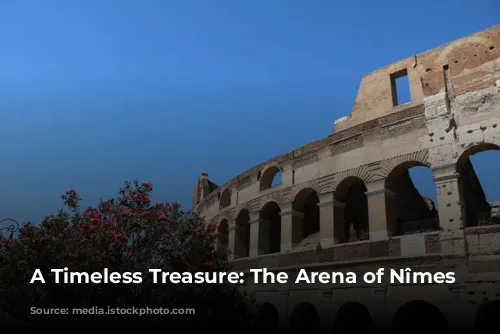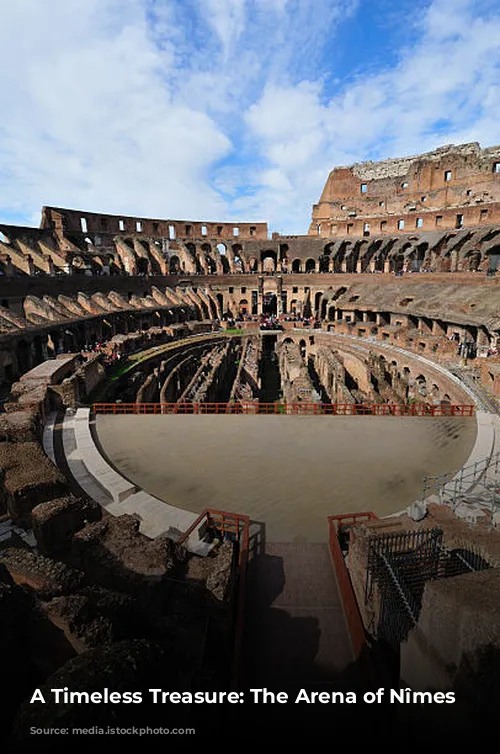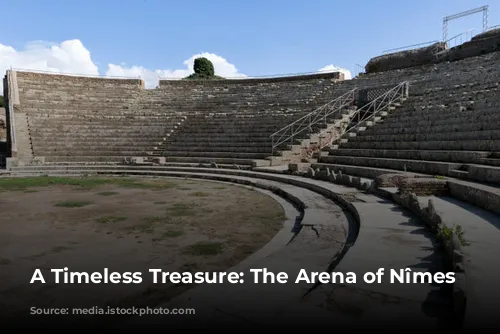The Arena of Nîmes, a grand Roman amphitheater in the heart of southern France, stands as a testament to the enduring power of ancient architecture. Built around 100 CE, shortly after the iconic Colosseum in Rome, it boasts an impressive size and remarkable preservation, making it one of the most well-preserved Roman arenas in the world.
The Arena’s imposing dimensions are truly awe-inspiring: 133 meters long and 101 meters wide, with an arena space measuring a substantial 68 by 38 meters. Its towering outer facade, reaching 21 meters in height, is adorned with two levels of 60 arcades, creating a striking visual spectacle. This colossal structure is among the 20 largest Roman amphitheaters out of the hundreds still standing today. In its heyday, the Arena could accommodate a massive audience of 24,000 spectators, distributed across 34 tiers of terraces divided into four distinct sections.
From Gladiatorial Battles to Modern Performances
During the Roman era, the Arena of Nîmes was a bustling hub of entertainment, hosting gladiatorial combats, thrilling animal fights, and other spectacular events. With the rise of early Christianity, these bloody spectacles came to an end, leading to a transformation of the amphitheater into a fortified stronghold, later serving as the foundation for a walled town. The 19th century witnessed the arena’s meticulous restoration, accompanied by the removal of houses that had been constructed within its walls.
Today, the Arena of Nîmes continues to thrive as a vibrant center of cultural activity. Every year, it hosts two traditional bullfights as part of the Feria de Nîmes, a renowned festival celebrating the region’s heritage. It also serves as a venue for a variety of public events, including the captivating “Great Roman Games” reenactment, which brings the ancient world to life. The Arena’s acoustics have also attracted renowned musicians, making it a popular stage for concerts ranging from rock to electronic music.
A Journey Through Time: The Arena’s Evolution
The history of the Arena of Nîmes is a fascinating chronicle of change and resilience. Roman amphitheaters, originating in southern Italy in the 2nd century BCE, were specifically designed to host grand spectacles. Their unique oval structure, created by merging two theaters face-to-face, allowed spectators to enjoy a panoramic view of the action unfolding below.
During the first and second centuries, the Roman Empire flourished, characterized by widespread prosperity and urbanization. However, the 3rd century brought about a period of profound instability. Civil wars ravaged the empire, barbarian tribes posed a growing threat, and epidemics compounded the crisis. The decline of gladiatorial combat, a predominantly urban phenomenon, mirrored the decline of the cities themselves.
From the 4th century onwards, the city of Nîmes began to withdraw and strengthen its defenses. The arcades of the amphitheater were sealed off, and the monument became an integral part of the city’s defenses. The Arena offered refuge to a significant portion of the city’s population, transforming into a fortified castle. Despite enduring numerous sieges, the Arena proved its effectiveness as a defensive structure. In 725, Arab forces from Spain conquered Nîmes, dismantling the Visigoth kingdom. Thirty years later, the Arabs were driven out by the Franks, who eventually established their rule over the city. However, Nîmes was merely a shadow of its former Roman glory.
A Resurgence of the Arena: From Fortress to Cultural Hub
It wasn’t until the 12th century that Nîmes experienced a period of renewal. As a testament to this revival, the Count of Toulouse granted his vassals in Nîmes permission to build a new city wall in 1194. This new wall followed a layout closely resembling the present-day boulevards of the city. The amphitheater, still a crucial element of the city’s defense system, gradually became a residential district. Over the course of the 14th century, the Arena’s military significance diminished, but it continued to be a populated area.
Inspired by the ideals of the Renaissance, King Francis I envisioned restoring the Arena to its original splendor. However, only a limited amount of work was carried out, involving the removal of structures from the first-floor gallery. By the 18th century, the arena still housed 150 residences with hundreds of inhabitants. The process of clearing the monument began in 1786, with the demolition of these encroaching houses. Two walled arcades, complete with their medieval windows, remain as a poignant reminder of this period, facing the Palace of Justice.
The architect Henri Revoil completed the Arena’s restoration in the mid-19th century. The first bullfight was held in 1853, marking the Arena’s return to its role as a venue for public spectacles. Since then, the Arena has continuously hosted a variety of events, including festivities, sporting competitions, entertainment, and bullfights.
A Legacy of Performance: The Arena’s Modern Impact
The Arena of Nîmes continues to attract international attention as a unique venue for concerts and performances. British rock band Dire Straits recorded part of their live video and album, On the Night, in 1992. German industrial metal group Rammstein filmed a significant portion of their DVD, Völkerball, within the Arena’s impressive walls. The arena has also hosted numerous music festivals and events, solidifying its position as a premier cultural destination.
The Arena’s enduring presence in Nîmes is a testament to the ingenuity and resilience of its builders. It stands as a reminder of the Roman Empire’s architectural prowess and its enduring legacy in the modern world. The Arena of Nîmes is not simply a historic monument; it is a living, breathing space that continues to connect generations through its unique blend of history, culture, and entertainment.
